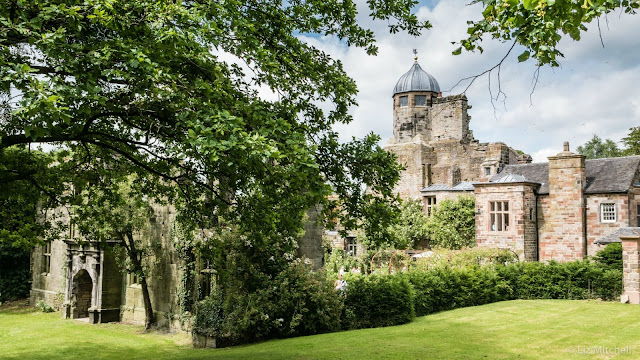Biddulph Old Hall Discovered
Roaring Meg and a giant teapot
We were in our local pub for an early evening drink recently, chatting to some old friends we hadn't seen for ages, when we were told, in glowing terms, about Biddulph Old Hall.
 |
| 15th Century and 17th Century parts of the hall |
This is a private home which once was a grand country house dating back to a hunting lodge in the 1400s, then a grand hall that was reduced to ruins in the English Civil War and is now, gradually, being renovated. It is open to the public only a couple of times a year, which is probably why we had never seen it before. It just so happened that this Saturday was one of the few days it was open to the public so we made our way there to see what the fuss was all about.
On arrival, just after midday, we were given a brief history of the building and introduced to the story of the original owners, the Biddulph family, and then to the Bateman legacy.
 |
| Introduction to the hall on the Open Day |
In the English Civil War Royalists, who were garrisoned here, were attacked by Parliamentarians and the hall was besieged by cannon fire, holes from the cannon balls can still be seen in the remaining shell of the ruined part of the hall. The largest hole was made by a cannon known as Roaring Meg.
 |
| Holes made by cannon in the Civil War in 1664 |
The current owners of the hall, Nigel Daly and Brian Vowles, are carefully restoring the old hall to its former glory and are living in the renovated parts of the building. We were able to take a look around the ground floor and some of the upper floor of the hall on our visit. The rooms were oak timbered with open fireplaces, fires lit even though it was a warm summer's day.
 |
| Fire burning in the fireplace next to the chapel |
The restored chapel was the location of the tearoom, where cups of tea were served from an enormous china teapot and were accompanied by a wonderful selection of homemade cakes.
 |
| An enormous china teapot! |
The south facing wall of the old hall is still standing, but within the walls there is now a garden featuring white flowers. The stonework surrounding the original entrance shows the date of 1589, when this part of the old hall was built.
 |
| Date on the remains of the old hall from 1589 |
Looking from the south east corner, on the left side are the ruins and on the right the renovated chapel, with an old tower still standing.
 |
| Ruined hall and renovated buildings |
The gardens are beautifully laid out and include a knot garden to the east side of the oldest part of the building. A garden to the west side has colourful purple roses and a cleverly angled mirror at the bottom of the tower wall that shows the Priest hole and escape tunnel that must have been used by the Biddulph family during the Civil War. They were Catholics and two of their sons were Jesuit priests.
 |
| Old hall and tower |
In the 1800s the hall was owned by James Bateman, the horticulturalist who also owned Biddulph Grange. One of his sons was the Pre-Raphaelite artist Robert Bateman who inherited Biddulph Old Hall and laid an engraved foundation stone in the chapel wall in 1874.
 |
| Dated stone inscribed by Robert Bateman in 1874 |
Inspired by his investigations into the previous owners of the hall one of the current owners, Nigel Daly, has written a book about Robert Bateman called
The Lost Pre-Raphaelite : The Secret Life & Loves of Robert Bateman
The renovation is still very much in progress, the chapel is currently being restored with a gallery overlooking the room below. The tower is still in need of some restoration. I will look forward to visiting again next year, if they have another open day, so I can see what changes have been made. It certainly was well worth a visit.

Comments
Post a Comment